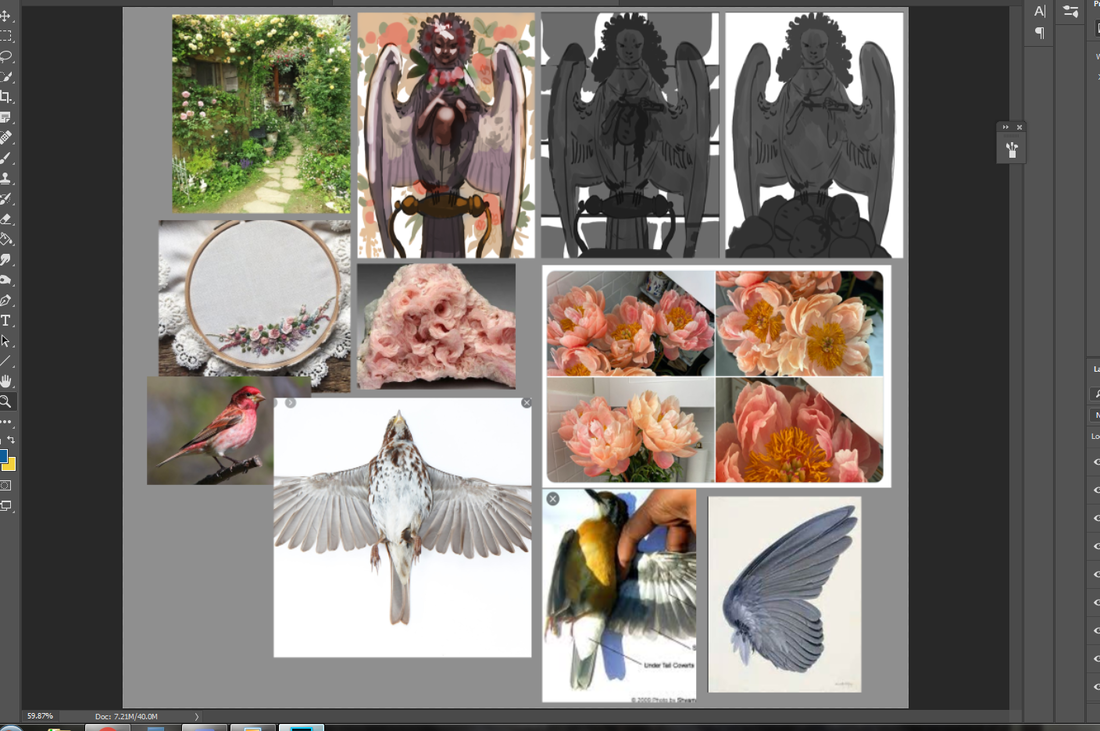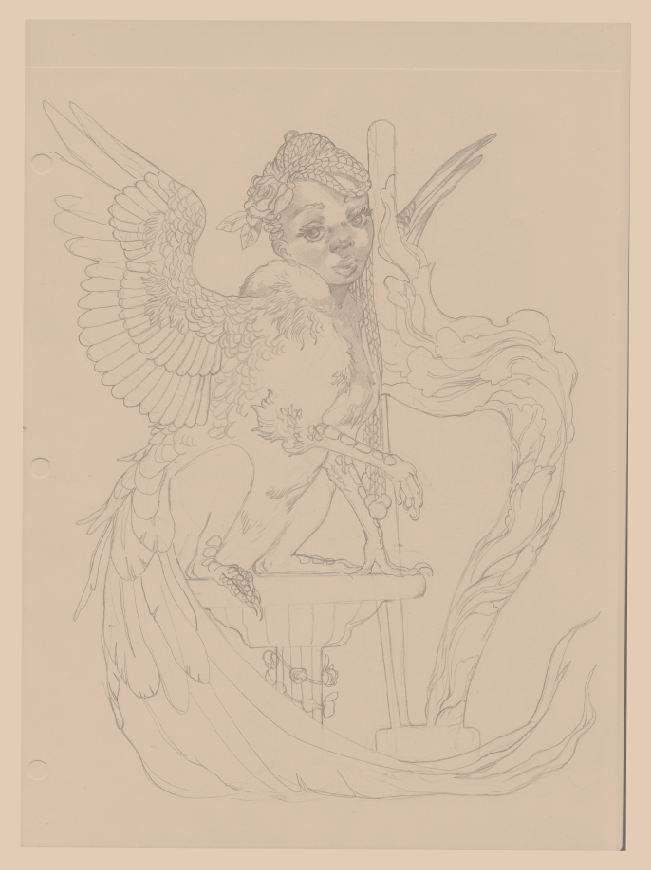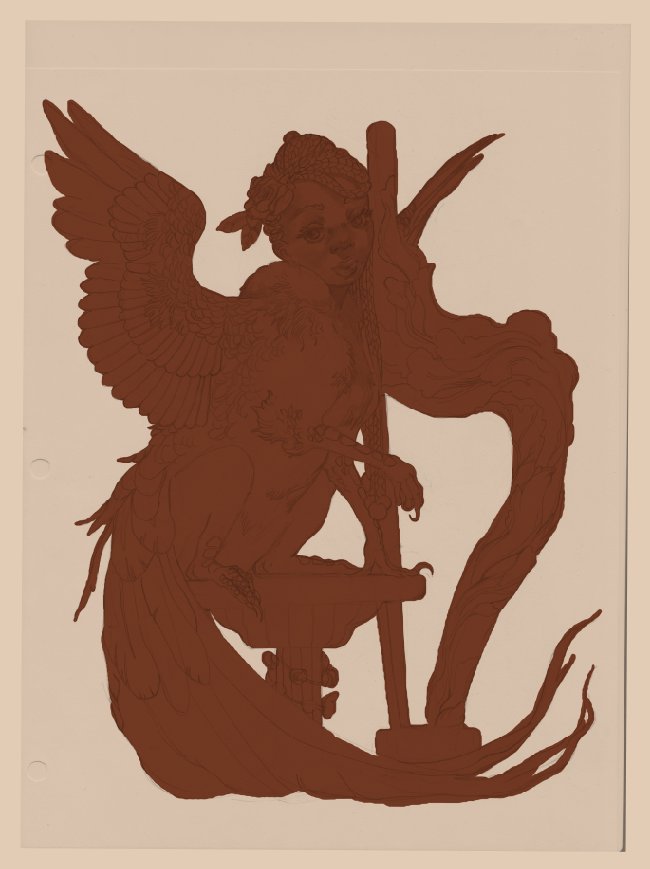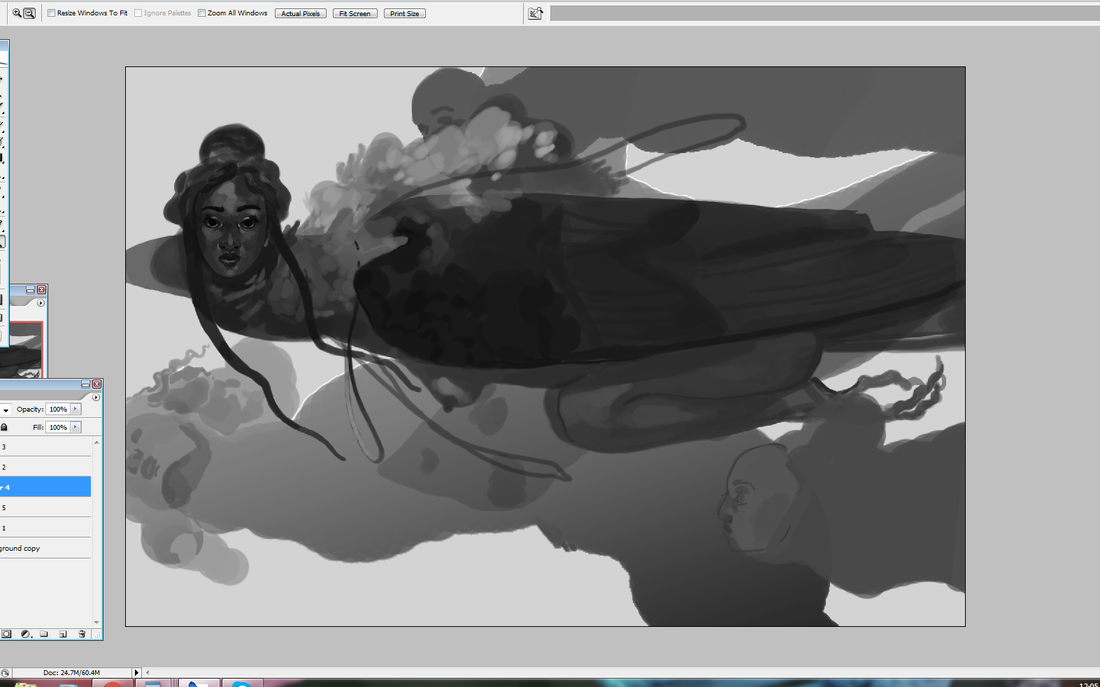|
Been a while since I've done one of these! Indulgent art has always held a high priority for me. Why bother painting or drawing things I'm not invested in? Not to mention I need to show what I want to get hired for, so...kill two birds with one stone. This piece, however, was peak indulgence. Like, a dollop of whipped cream on top of whipped cream indulgence. You have a harpy. You have flowers. You have a ton of colors. Hell, there are even the mildest of vaporwave vibes (pink + blue surrealism) that snuck in without me realizing. Expect to see more of that. This year has been an absolute trainwreck and it's barely halfway over. Soaking in the subjects and styles I love to the nth degree is as self-care as it gets. As a side-note, I'm going to be keeping these progress posts a little brief from now on so I don't repeat myself. I mean, you know I love color. The part where I start phasing out the sketch and start rendering is orgasmic. Yadda yadda. I'll focus more on the unique challenges of each piece and what, exactly, was going on in my mind when making it. It's time to get indulgent.
0 Comments
It's that time again. The autumn leaves are falling, our fingertips are freezing and the Inktober event is in full swing. ...Ish. I made a poll at the beginning of the month asking for thoughts on Inktober, the popular October art tradition: the consensus was non-committal, with the majority either being wishy-washy on the idea or outright refusing. Is it any surprise? Making art is already enough of a process without churning out daily pieces, which are disruptive by nature due to being free work sandwiched in-between jobs, school and life obligations. This response is on top of countless counterposts I've seen just browsing my feed. For health-related reasons or not having enough time, I'm really happy to see artists prioritizing other things, to be honest. Burnout is a pretty serious issue without adding FOMO to the mix. Burnout is so serious, in fact, it can literally make you sick. It's an easy trap to fall into as a freelancer, as well, since you're in the position of having to dictate your own hours and find your own work. Getting said work? Often means creating free work in the hopes of someday being paid for it. More than once I've found myself working ridiculously long days without a full break. I've even come down with illnesses that don't usually affect my age group (which I'll talk about in a later post). Does that mean I'm against the concept of Inktober or any variant thereof? Not at all! Daily art exercises have their time and place: 1. They're a smart way to nip overthinking in the bud (how many pieces lie unfinished because of too much prep work?). 2. They supplement portfolios with smaller pieces (great for blogging and/or Patreons). 3. They're great practice and, with the right mindset, a ton of fun. If you're feeling guilty for not participating, however...that's when you're deprioritizing artistic growth in favor of FOMO: a fluff goal for shallow social media attention that doesn't amount to anything substantial. Art deserves better than that, right?
You want to be a character designer? Design characters. You want to be a concept artist? Create concepts for a hypothetical product or videogame. You want to be an animator? Animate. This advice may come across as intentionally obtuse, but so much of the narrative surrounding working artists is...convoluted. There are far too many art schools out there with archaic curriculums that exhaust rather than inspire. The amount of horror stories I hear from working professionals with degrees? It'd make your head spin (if you aren't one of those postgraduates already). Capitalism also has many of us afraid to specialize in one or two paths due to the inherent instability of the job market. Hell, just living your life and juggling time between kids, a part-time job and/or school? Underfed possibility will have you overwhelmed by the time you sit down to work on your art. I'm no stranger to it. Contrary to what you may hear, specializing is actually a good thing. A major reason I get work in fantasy illustration...is because I draw and paint a lot of fantasy. No attempts to be a jack-of-all-trades doing every last style under the sun, no self-flogging because I'm still weak in some areas (like urban cityscapes). I do what I like and I get hired to do what I like. Just like a gymnast has to do a set of repetitions thousands of times, so too do you need to draw something over and over before you get really good at it. All of this would've been harder if I spent a big chunk of time painting, say, cars (which I could really care less about). This isn't to say life experiences outside of art are unimportant, nor that variety is a waste of time. Far from it. The best art comes from a wealth of first-hand, lived experiences -- it's a reflection of life, after all, and art that lacks a healthy foundation will show its cracks. Over the past ten years I've gone from being an educational ASL interpreter to several barista positions to B2B writing. I've learned so much about myself and have drawn on these life experiences to improve my craft. All the while? I've drawn and painted what I wanted to. What made my mind, heart and soul sing. I sometimes wavered on this over the years, wondering if I was 'limiting myself' because I leaned toward a certain style and handful of genres. Whether you are leaning toward human subjects, a shoujo-esque style or wanting to commit to a sequential art major, you are limiting yourself...so you can specialize and become a master of one. Variety is important and specialization is not a curse. I've talked before about how language matters. The art industry is ever in need of nuance. Here we're going to take a look at another old character of mine, a pheasant-griffon sphinx that embodies so much of what I love to paint: I'll never lose touch with my eight year-old self filling in a coloring book.
Sometimes you don't know how a piece is going to turn out. It's the eternal conundrum: do you keep going with a sketch that's quite not working...or start over? Then there are the times you don't know what the hell you're doing at all. I've gotten better at resolving this over the years. At this point I can tell when something isn't going to go where I want it to, no matter how hard I try. One common sign of this is when I rework a certain area of a painting over and over and over. Other times I'll notice something is wrong when there is an abnormally huge gap between the preliminary stages and the final sketch. Art is a conversation. It'll go in places you don't always expect and, just like any dialogue, you should take warning signs at face value. Sometimes, though...unpredictability is your friend. Sometimes you're not sure where your art is going...and that's the best part. The pieces are laid before you, the ideas and the mood are there, but you haven't arranged them into anything resembling sense yet. This is, honestly, one of my favorite ways to paint. This illustration below originally started out as a bunch of ovals and circles. No thumbnail. No rough draft or references. Just a mess of blobs I shuffled around until they gradually formed an image in my head. This tends to be what I do when I'm having a hard time creating work and want to push myself. As is my wont, I go for a half-human creature. What can I say? I know what I like.
|
AuthorHere I post WIPs, sketches, speedpaints, thumbnails and anything else thrown into the veritable stew of artistic process. Archives
January 2021
Categories
All
|
ServicesBook Covers
Illustration Character Art Portraits Packaging Art Concept Art |
AboutCommercial illustrator and designer currently available for short-term and long-term freelance work.
|
© COPYRIGHT 2015. ALL RIGHTS RESERVED.
|




 RSS Feed
RSS Feed